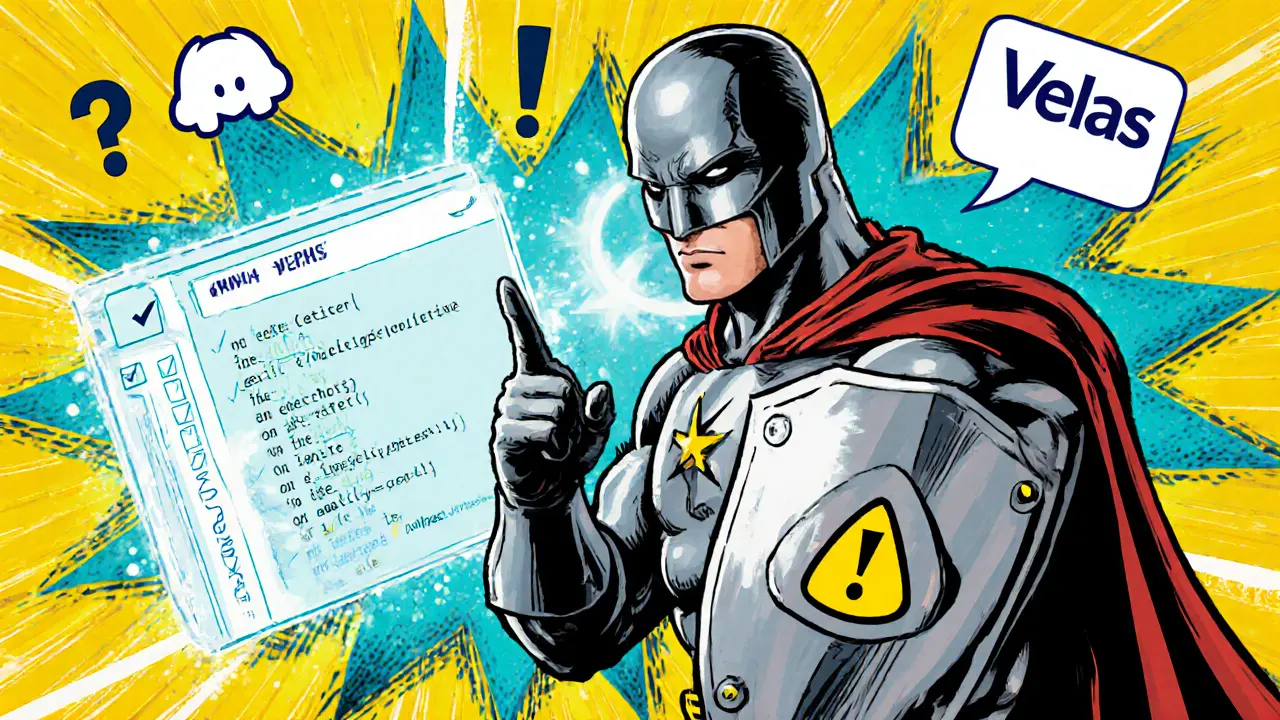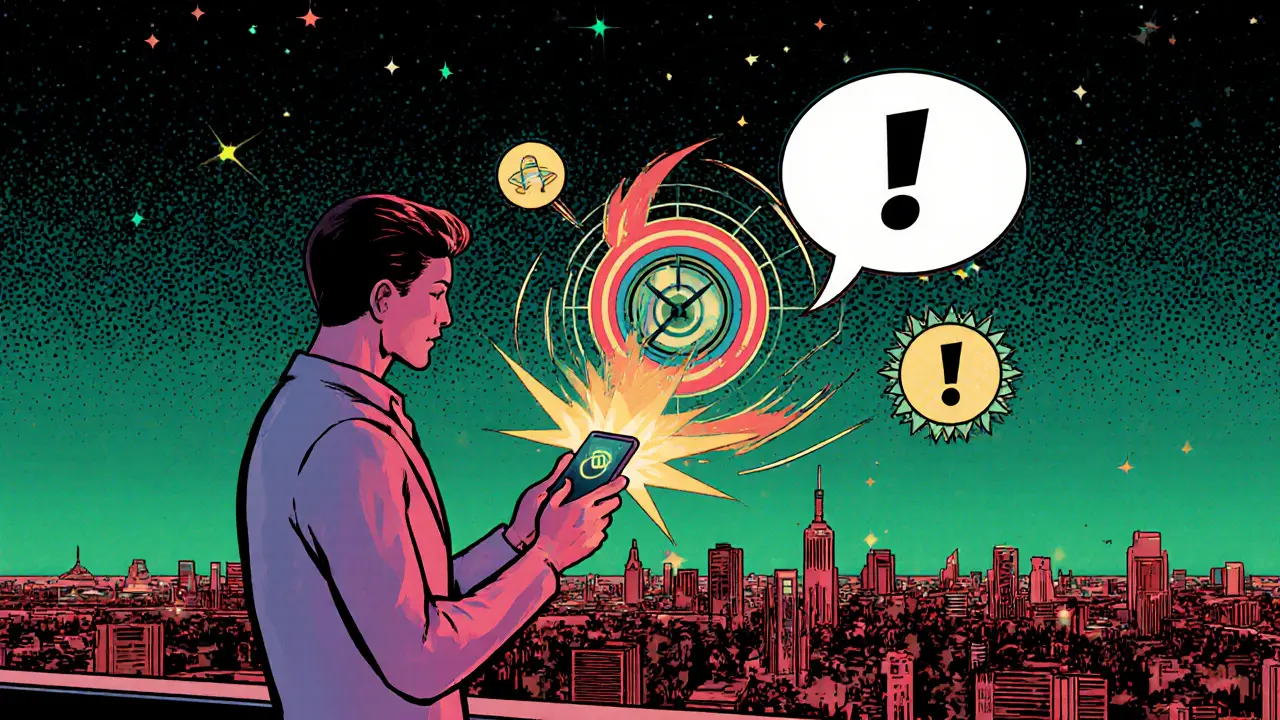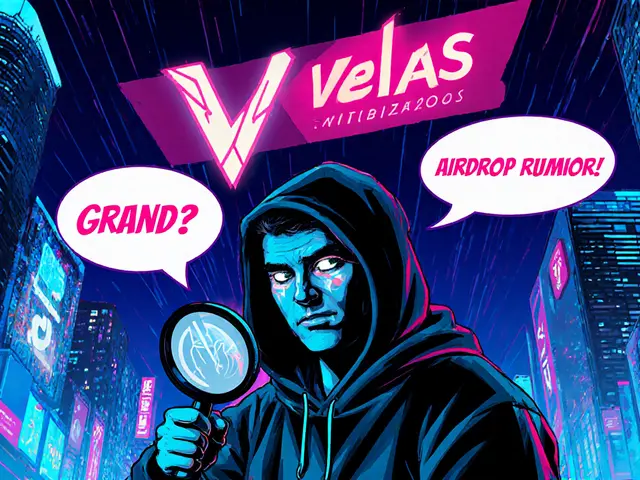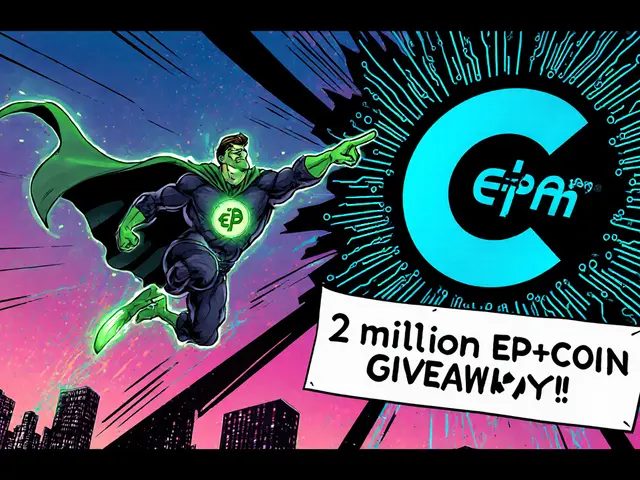Velas Airdrop Contract Verifier
Verify Contract Address
Enter a contract address to check if it's legitimate for a Velas airdrop.
Quick Takeaways
- The "GRAND" airdrop for VLX has not been officially announced by Velas.
- Legitimate airdrops always come from Velas’ verified channels - Discord, Twitter, or the official website.
- Never share private keys; use a fresh, non‑custodial wallet to claim any token.
- Check the smart‑contract address on a block explorer before interacting.
- Follow the step‑by‑step safety checklist below to avoid scams.
Crypto enthusiasts love airdrops because they can turn a simple tweet into free tokens. When a name like Velas a high‑performance, EVM‑compatible blockchain that uses a combination of Delegated Proof‑of‑Stake and Artificial Intelligence to boost transaction speed appears next to the word “GRAND,” the hype meter spikes. But without an official announcement, the rumors can be just noise - or worse, a phishing trap.
This guide walks you through everything you can verify about a potential Velas airdrop, how to claim it safely, and the warning signs that separate genuine giveaways from scams. Whether you’re a seasoned holder of VLX the native utility token of the Velas ecosystem, used for staking, gas fees, and governance or a newcomer curious about the hype, the steps below will keep your assets out of the hands of attackers.
What is Velas and Why Does Its Token Matter?
Founded in 2019, Velas combines a delegated proof‑of‑stake (DPoS) consensus with AI‑driven block propagation. The result is sub‑second finality and fees that are often lower than Ethereum’s. Because the network is EVM‑compatible, developers can deploy Solidity contracts without rewriting code.
The VLX token powers three core activities:
- Staking - delegators earn rewards for securing the network.
- Gas - paying for smart‑contract execution.
- Governance - voting on protocol upgrades.
These utilities make VLX attractive for airdrop targets: a free token can instantly give recipients the ability to interact with DeFi apps, bridge to other chains, or simply hold a potentially appreciating asset.
Understanding Crypto Airdrops
An airdrop is a distribution method where a project sends tokens to a group of wallets for free or in exchange for a simple action (following a social account, completing a KYC, or holding a certain token). Airdrops serve two main purposes: marketing (spreading awareness) and decentralization (widening the holder base).
Legitimate airdrops usually follow a clear roadmap:
- Announcement on official channels.
- Eligibility criteria - often holding a specific token at a snapshot date.
- Claim period - a limited window where users interact with a smart contract or a web UI.
- Distribution - tokens appear in the wallet after the claim window closes.
Because the process is public and on‑chain, you can verify every step using block explorers like Velas Explorer or Etherscan (if it’s a bridged token).

The Rumored “GRAND” Airdrop - What We Know So Far
As of October 2025, Velas has not posted any official statement about a “GRAND” airdrop. The chatter stems from social‑media posts that reference a “GRAND” token distribution, often paired with screenshots of fake claim pages. Here’s what you can confirm today:
- Source verification - No blog post, Discord announcement, or Twitter thread from the verified @Velas_Official accounts mentions GRAND.
- Smart‑contract address - No contract with the name “GRAND” appears on Velas Explorer.
- Community response - The official Velas community moderators have repeatedly warned users about impersonation attempts.
That doesn’t mean Velas won’t launch a sizable airdrop later in the year, but until a formal notice appears, treat any “GRAND” claim link as unverified.
How to Safely Participate in Any Velas Airdrop
If Velas announces a genuine airdrop, follow this checklist to protect yourself:
- Secure a fresh, non‑custodial wallet. Use MetaMask, Trust Wallet, or the official Velas Mobile Wallet. Create a new seed phrase that you store offline.
- Add the VLX token. In MetaMask, use the contract address
0x... (official address)- verify on Velas Explorer. - Confirm the announcement. Check the Velas blog (velas.com/blog), verified Twitter, or the Discord #announcements channel. Look for the exact phrasing, dates, and official graphics.
- Read the eligibility rules. Common requirements include:
- Holding a minimum amount of VLX at a snapshot.
- Completing a short KYC (if required).
- Joining the Velas Telegram group.
- Verify the claim contract. When the claim page opens, copy the contract address and paste it into Velas Explorer. Look for:
- Verified contract source code.
- Read‑only functions for claiming.
- No “approve” transaction that could move your existing VLX.
- Execute the claim. Connect your wallet, sign the transaction, and wait for confirmation. The tokens will appear in your wallet after the block finalizes.
- Double‑check the balance. Refresh the wallet UI and verify the token amount matches the announced distribution.
By keeping each step separate, you limit the chances that a malicious site silently steals your private key or drains your existing holdings.
Red Flags - Spotting Fake Airdrop Pages
| Indicator | Legitimate | Scam |
|---|---|---|
| Source URL | Official velas.com sub‑domain or known wallet UI | Random .xyz, .top, or typo‑squatted domains |
| Contract address | Matches address published on Velas Explorer | New, unverified address with no source code |
| Permission requests | Only signature for claim - no token approval | Requests to “approve all tokens” or “transfer all funds” |
| Community verification | Confirmed by official moderators in Discord/Twitter | Only promoted by unknown influencers or private groups |
| Urgency language | Clear timeline but no false‑deadline pressure | “Claim now or lose forever!” pop‑ups |
When in doubt, pause and ask the community. A quick search like “Velas official airdrop” on Reddit or the Velas Discord will usually surface any known scams.

Key Concepts Behind Airdrop Mechanics
Understanding the tech helps you evaluate legitimacy. Here are three pillars:
- Smart contract self‑executing code on the blockchain that enforces the distribution rules without a central party. A well‑audited contract will show read‑only claim functions and no back‑door withdrawal functions.
- Tokenomics the economic design of a token, covering supply, allocation, inflation, and utility. Airdrops that allocate >5% of total supply at once can signal a token‑dump risk.
- KYC verification Know‑Your‑Customer process to comply with regulations; legitimate projects may require it, but never ask for private keys. If a site asks for your seed phrase, walk away.
Balancing these factors lets you decide whether an airdrop adds real value or is just a marketing gimmick.
Next Steps - Staying Informed About Velas Updates
To catch a real GRAND or any future Velas distribution, set up these alerts:
- Follow @Velas_Official on Twitter - enable mobile notifications.
- Join the official Discord server; enable @everyone pings for #announcements.
- Subscribe to the Velas newsletter via the website - they often send airdrop notices first to email subscribers.
- Bookmark Velas Explorer and add the VLX contract to your wallet’s watchlist for automatic balance updates.
While the GRAND airdrop remains unverified, staying plugged into these channels ensures you won’t miss a legitimate opportunity.
Frequently Asked Questions
Is there an official Velas GRAND airdrop right now?
No. As of October 2025, Velas has not published any official announcement about a GRAND airdrop. Any claim page that references GRAND should be treated as suspicious until verified by the official Velas channels.
How can I verify a Velas airdrop contract?
Copy the contract address shown on the claim page, paste it into Velas Explorer, and confirm that the source code is verified and matches the address published in the official announcement.
Do I need to complete KYC to receive a Velas airdrop?
Only if the official announcement states so. Some airdrops require KYC for regulatory compliance, but a legitimate project will never ask for your private key during KYC.
Can I claim an airdrop using a hardware wallet?
Yes. Hardware wallets like Ledger or Trezor can connect to Metamask (set to Velas network) and sign the claim transaction, providing the highest security.
What should I do if I accidentally entered my seed phrase on a fake site?
Immediately move any assets to a brand‑new wallet with a fresh seed phrase. Consider using a blockchain analytics service to monitor the compromised address for suspicious activity.



Marina Campenni
October 18, 2025 AT 09:19I appreciate the thoroughness of this guide; it clearly separates verified channels from potential scams. Following the checklist can save many users from costly mistakes.
Irish Mae Lariosa
October 22, 2025 AT 02:12The landscape of cryptocurrency airdrops has evolved considerably over the past few years, and the Velas ecosystem is no exception; while the promise of a “GRAND” distribution understandably generates excitement, the absence of any official confirmation necessitates a cautious approach. First, it is essential to recognize that legitimate projects invariably publish announcements through their verified communication platforms, such as the official Velos Discord, Twitter, or blog; any deviation from these channels should raise immediate doubts. Second, it is essential to recognize that legitimate projects invariably publish announcements through their verified communication platforms, such as the official Velos Discord, Twitter, or blog; any deviation from these channels should raise immediate doubts. Third, the technical verification of a smart‑contract address on a reputable block explorer provides an immutable record that can be cross‑referenced against the information supplied by the project. Fourth, community moderators, who are often volunteers but act as custodians of the ecosystem’s reputation, frequently issue warnings about impersonation attempts, and these warnings should be taken seriously. Fifth, the practice of demanding private keys or seed phrases is a red flag that unequivocally indicates a fraudulent scheme, as no reputable entity will ever request such sensitive data. Sixth, the design of a genuine airdrop typically includes a clear snapshot date, eligibility criteria based on token holdings, and a defined claim window that is communicated well in advance. Seventh, the implementation of a claim contract should be transparent, with source code verified and read‑only functions that prevent unauthorized token transfers. Eighth, users should always employ a fresh, non‑custodial wallet when interacting with airdrop claim pages to isolate potential risks. Ninth, the use of hardware wallets, where feasible, adds an additional layer of security by ensuring private keys never leave the device. Tenth, after the claim transaction is submitted, it is prudent to verify the receipt of tokens on the explorer before assuming success. Eleventh, any urgency language such as “claim now or lose forever” is commonly employed by scammers to create panic and should be ignored. Twelfth, it is advisable to bookmark the official Velas website and subscribe to their newsletter, as these channels often provide the first legitimate notice of upcoming distributions. Thirteenth, community members can collectively investigate suspicious links by sharing screenshots and URLs in the official Discord or subreddit, thereby protecting newcomers. Fourteenth, the broader lesson here is that due diligence, verification, and a healthy dose of skepticism are indispensable tools in navigating the airdrop ecosystem. Fifteenth, while the prospect of a free token may be tempting, the potential loss incurred by falling for a scam far outweighs any short‑term gain. Finally, maintaining a disciplined habit of cross‑checking every piece of information will ensure that you remain on the right side of the security line and can participate safely when a genuine Velas airdrop eventually materializes.
Nick O'Connor
October 25, 2025 AT 19:06When examining any claimed airdrop, remember to verify the source URL, check the contract address on Velas Explorer, and compare it with the official announcement; these steps, while simple, are crucial, and skipping any of them could expose you to phishing attacks, especially if the site requests unnecessary permissions, such as token approvals, which are not typical for legitimate claims.
Deepak Kumar
October 29, 2025 AT 11:59Hey folks, if you’re gearing up for a potential Velas airdrop, start by setting up a brand‑new wallet – think MetaMask or the official Velas Mobile – and keep that seed phrase offline, safe, and never share it. Then add the VLX token using the official contract address, double‑check everything on Velas Explorer, and finally, when the official claim page drops, sign only the claim transaction; this way you keep your funds locked tight and the scammers out.
Matthew Theuma
November 2, 2025 AT 04:52Just a heads‑up, the community vibe around this “GRAND” rumor feels more hype than substance 🌟, so keeping an eye on the official channels will save you a lot of hassle later.
Carolyn Pritchett
November 5, 2025 AT 21:46Honestly, the flood of fake “GRAND” links is the worst junk you can find on crypto forums; anyone posting them should be banned for spreading scams that only benefit fraudsters.
Hailey M.
November 9, 2025 AT 14:39Oh great, another “GRAND” airdrop that turns out to be a phishing trap – just what the internet needed, another excuse to ruin my day with a fake claim page. 🙄
DeAnna Brown
November 13, 2025 AT 07:32Can you imagine actually getting a massive Velas airdrop? That would be EPIC, and I’m already dreaming about the lunar pizza parties we could throw with all those free tokens!
Chris Morano
November 17, 2025 AT 00:26Stay positive, keep your wallet secure, and you’ll be ready when a real opportunity appears.
Ikenna Okonkwo
November 20, 2025 AT 17:19In the grand scheme, airdrops are a marketing tool, but they also reflect a project’s willingness to distribute value to its community; evaluating them with both skepticism and openness is the key.
Jason Zila
November 24, 2025 AT 10:12Make sure any claim contract is verified before you sign.
Cecilia Cecilia
November 28, 2025 AT 03:06Official Velas channels have not announced a GRAND airdrop.
lida norman
December 1, 2025 AT 19:59This whole rumor is like a horror movie – the tension builds, the unknown looms, and then the reveal? Nothing but an empty promise! 😱